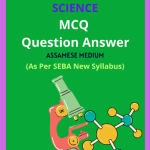Class 8 Science MCQ Chapter 10 Reaching The Age of Adolescence Solutions in English Medium, Class 8 Science Multiple Choice Question Answer in English to each chapter is provided in the list so that you can easily browse throughout different chapters Class 8 Science MCQ Chapter 10 Reaching The Age of Adolescence Notes and select need one.
Class 8 Science MCQ Chapter 10 Reaching The Age of Adolescence
Also, you can read the SCERT book online in these sections Class 8 Science Objective Type Solutions by Expert Teachers as per SCERT (CBSE) Book guidelines. These solutions are part of SCERT All Subject Solutions. Here we have given Assam Class 8 Science MCQs Solutions in English for All Subject, You can practice these here.
Reaching The Age of Adolescence
Chapter – 10
| MCQ |
1. What is the primary physical change during adolescence?
(a) Decrease in height.
(b) Growth spurt.
(c) Increase in body fat.
(d) Decrease in muscle mass.
Ans: (b) Growth spurt.
2. At what age does puberty typically start for girls?
(a) 7-8 years.
(b) 9-10 years.
(c) 11-12 years.
(d) 13-14 years.
Ans: (c) 11-12 years.
3. Which hormone is primarily responsible for the development of secondary sexual characteristics in boys?
(a) Estrogen.
(b) Progesterone.
(c) Testosterone.
(d) Insulin.
Ans: (c) Testosterone.
4. What is the term for the onset of menstruation in girls?
(a) Menarche.
(b) Menopause.
(c) Ovulation.
(d) Puberty.
Ans: (a) Menarche.
5. Which cognitive ability develops during adolescence?
(a) Concrete operational thinking.
(b) Abstract thinking.
(c) Egocentric thinking.
(d) Sensorimotor skills.
Ans: (b) Abstract thinking.
6. During adolescence, individuals often experience which of the following?
(a) Stable mood.
(b) Increased emotional stability.
(c) Intense mood swings.
(d) Decreased emotional sensitivity.
Ans: (c) Intense mood swings.
7. What is a common social change during adolescence?
(a) Increased importance of family relationships.
(b) Decreased importance of peer relationships.
(c) Increased importance of peer relationships.
(d) Decreased social interaction.
Ans: (c) Increased importance of peer relationships.
8. What is the term for the process of exploring different roles and beliefs during adolescence?
(a) Identity diffusion.
(b) Identity foreclosure.
(c) Identity formation.
(d) Identity confusion.
Ans: (c) Identity formation.
9. Which of the following is NOT a typical risk-taking behavior during adolescence?
(a) Experimenting with drugs.
(b) Engaging in risky sports.
(c) Following safety rules.
(d) Reckless driving.
Ans: (c) Following safety rules.
10. What is the typical age range for the onset of puberty in boys?
(a) 7-8 years.
(b) 9-10 years.
(c) 11-12 years.
(d) 13-14 years.
Ans: (c) 11-12 years.
11. Which gland is primarily responsible for producing hormones related to puberty?
(a) Thyroid gland.
(b) Pituitary gland.
(c) Adrenal gland.
(d) Pancreas.
Ans: (b) Pituitary gland.
12. What is the term for the stage of cognitive development that allows adolescents to think logically about abstract concepts?
(a) Preoperational stage.
(b) Concrete operational stage.
(c) Formal operational stage.
(d) Sensorimotor stage.
Ans: (c) Formal operational stage.
13. What significant emotional change often occurs during adolescence?
(a) Decreased sensitivity to peer feedback.
(b) Increased stability in emotional responses.
(c) Greater intensity in emotions.
(d) Reduced self-consciousness.
Ans: (c) Greater intensity in emotions.
14. During adolescence, which area of the brain shows significant development?
(a) Cerebellum.
(b) Amygdala.
(c) Prefrontal cortex.
(d) Medulla oblongata.
Ans: (c) Prefrontal cortex.
15. Which behavior is commonly associated with adolescence?
(a) Increased adherence to parental rules.
(b) Decreased social independence.
(c) Increased exploration of personal interests.
(d) Reduced interest in peer relationships.
Ans: (c) Increased exploration of personal interests.

Hi! my Name is Parimal Roy. I have completed my Bachelor’s degree in Philosophy (B.A.) from Silapathar General College. Currently, I am working as an HR Manager at Dev Library. It is a website that provides study materials for students from Class 3 to 12, including SCERT and NCERT notes. It also offers resources for BA, B.Com, B.Sc, and Computer Science, along with postgraduate notes. Besides study materials, the website has novels, eBooks, health and finance articles, biographies, quotes, and more.



